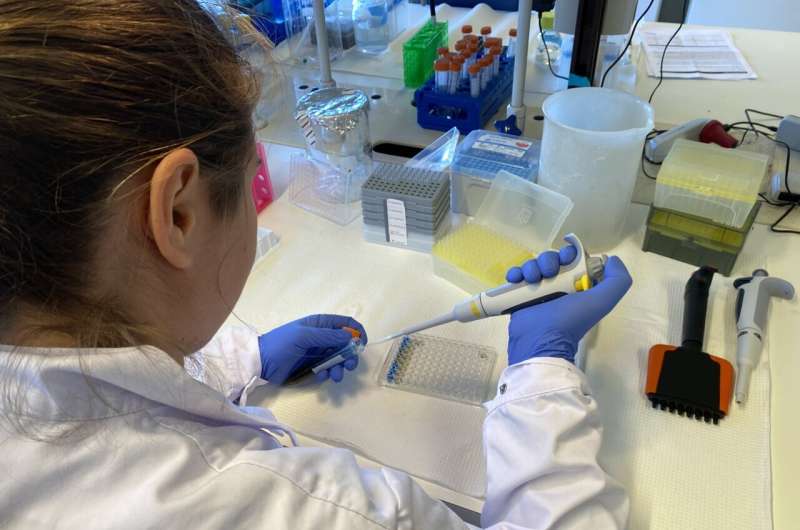Ph.D. student Sophie Bresson of the University of Oslo applied pollutants to beta cells from rats to see how they reacted. Credit: Cecilie Bakken Høstmark, UiO
The environmental pollutants we consume are probably the reason why some people develop type 1 diabetes. Even low concentrations of such pollutants can result in cells producing less insulin, reveals a new study from the University of Oslo (UiO).
Around 400 children and adolescents are diagnosed with type 1 diabetes every year in Norway and the number of new cases among children and adolescents has doubled since the 1970s. Adults are also diagnosed with the disease.
Type 1 diabetes is an autoimmune disease characterize by a destruction of the beta cells of the pancreas that produce insulin. The body's own defense system makes the mistake of believing that these insulin-producing cells are harmful alien cells that need destroying.
What triggers the onset of type 1 diabetes remain unclear for scientists. Could it be hereditary? Environmental factors relating to diet, polluted drinking water or could it be due to a viral infection?
Researchers found more environmental pollutants in the blood of children with type 1 diabetes
In collaboration with the University of Tromsø and several research teams in the U.S., scientists at UiO have studied the environmental pollutants in blood samples from American children and adolescents who have been diagnosed with type 1 diabetes. These were compared with blood samples from a control group not suffering from type 1 diabetes.
"We found that a larger proportion of those with type 1 diabetes had such pollutants in their blood. On average, they also had a higher concentration of several types of environmental pollutants," says Sophie E. Bresson, Ph.D. student at the Department of Molecular Medicine at the Institute of Basic Medical Sciences at the University of Oslo.
In order to examine these findings in more depth, the researchers used beta cells from rats. The toxic substances were applied to these cells to find out what happened next.
"We found that the beta cells then produced much less insulin, even after only two days and with very low concentrations of environmental pollutants. When the beta cells were exposed to the pollutants for a longer period of time, they died. We therefore believe that environmental pollutants play a role in triggering the onset of type 1 diabetes," says Bresson.
Bresson, professor Jerome Ruzzin and the research team recently published their findings in an article in the journal Environment International.
Environmental pollutants are a global threat to mankind
Several of the environmental pollutants studied by the research team, such as PCBs and pesticides, were banned 20 years ago by the Stockholm Convention. But these substances are found in food, plastics, paints, building materials, soil and water and are only broken down naturally to a small degree. They may also have been trapped by ice, and when the ice melts due to global warming, the pollutants are released.
In addition, a number of countries that did not sign the Convention still continue to use these substances to prevent insects attacking crops.
"We consume most environmental pollutants via the food we eat. Once these pollutants enter the body, there is unfortunately nothing we can do to eradicate them," says Bresson.
As part of the study, the researchers obtained blood samples from the US. Could the level of environmental pollutants there differ from that of Norway?
"We have no reason to believe that there are significant differences. But we need to find out for sure," says Bresson.
Eat less meat and more lean fish
90% of the environmental pollutants we consume via food come from fish, meat and dairy products, explains professor Jason Matthews at the Department of Nutrition at the University of Oslo.
The scientists point out that fatty fish such as herrings, mackerel, halibut, salmon and trout contain more dioxins and dl-PCB than lean fish filets. Examples of lean fish are coalfish, cod and haddock.
So what can we do to reduce the level of environmental pollutants in our food?
"Eating less meat can be a good place to start, and choose lean fish. Ecologically cultivated foods will contain fewer trace elements of pesticides since they are not sprayed, but they will still absorb pollutants via water and the soil," says Matthews.
More information: Sophie E. Bresson et al, Associations between persistent organic pollutants and type 1 diabetes in youth, Environment International (2022). DOI: 10.1016/j.envint.2022.107175
Journal information: Environment International
Provided by University of Oslo
























